By Jean-Claude David
The Ghazala House[1] Project: from the large city dwelling to the Museum of Aleppo Memory (Mathaf Zakirat Halab)
In 2009, two years before the beginning of the conflict in Syria, descendants of the Ghazaleh family had wished to perpetuate the memory and expand awareness of their ancestral home in Aleppo. Our publication Alep: La maison Ghazalé – Histoire et devenirs (Editions Parenthèses, 2019) is the outcome of these efforts. The aim was to make known the ancient splendour of this architecture and to convey an idea of the quality of life that animated it. The many written, drawn and photographed testimonies presented in our book also constitute an important documentation for any restoration that would be undertaken after the almost complete destruction of the house during the war. As a particularly elaborate example of a large house that could have been inhabited by an Aleppine family of any denomination, it was ideally suited to accommodate a museum of Aleppine and Syrian history and identity.
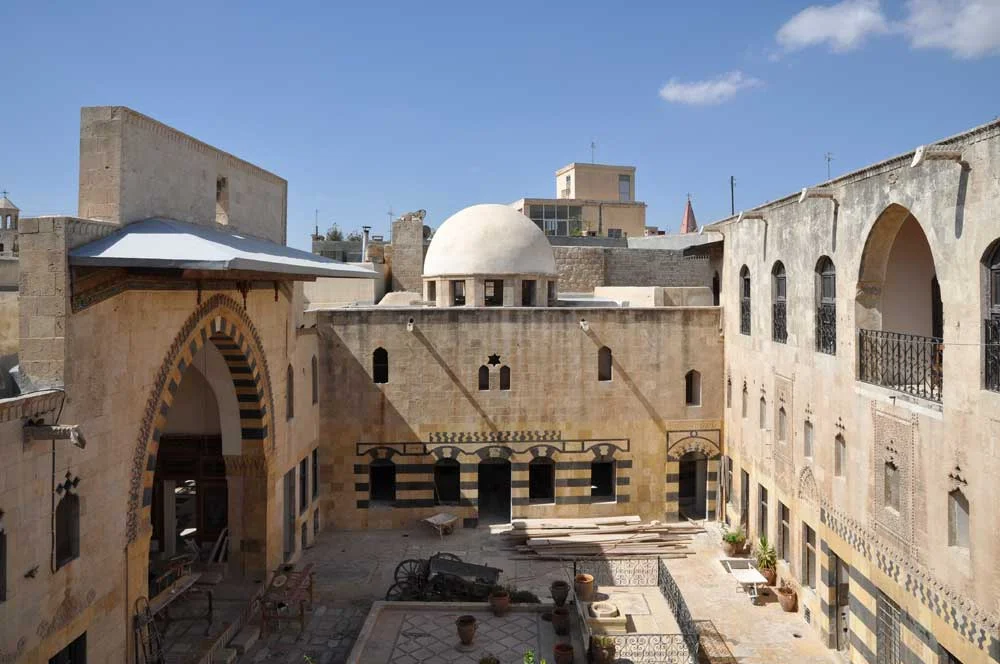
As it stood in 2011, the Ghazala House had been built mainly in the 17th and 18th centuries and was inhabited from the beginning by Christian families (Fig. 1, 4). Did this confessional anchoring make its heritage special? The description and analysis of several houses built and inhabited by Christians show that there are no essential differences between a ‘Christian house’ and a ‘Muslim house’ from the same period. Culture, both tangible and intangible, builds itself with the most diverse materials, but also the plurality of religions. The houses display very few characteristics peculiar to Islam, to Christianity or to the Armenian, Catholic, Orthodox or Jewish identities. On the contrary, there is a strong presence of Arabic script and literature, the language common to all, as well as the pre-Islamic heritage that they incorporate. Everything attests that non-Muslim elements are not exogenous, but a breeding ground for the cultural and historical development of a common heritage.
Was the Ghazale House a target during the battle?
In 2010, the Ghazala House, a historical monument and former place of everyday life, had been uninhabited for more than a century. The break caused by changing lifestyles at the end of the 19th century and the adoption of a certain kind of modernity had been accompanied by a rejection of the past. In the 2000s, the house was taken into the care of Syria’s General Directorate of Antiquities and Museums to establish a Museum of Aleppine Memories. The work began with its restoration, followed by the preparation of the collections to be exhibited.
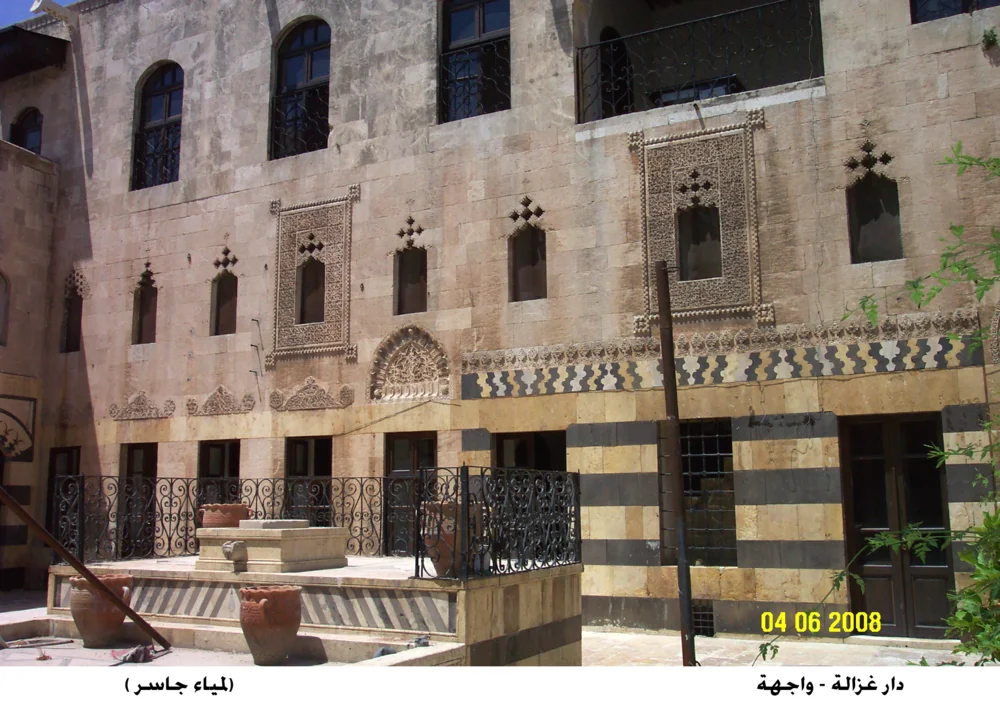
But by autumn 2012, shortly after the start of the war in Aleppo, the front line passed very close to the house. The recently restored wood panelling was dismantled and taken away, presumably by organised and protected looters. The house first escaped destruction. For three years the front line moved little, yet in 2015 it did shift and the fighting intensified for the re-conquest of territories occupied by the rebels. The Judayda Quarter, which is very rich in monuments and tourist attractions, was deeply affected by underground explosions, mortar bombardments, aerial shelling and ground fighting. Some of the destruction seems to have precisely targeted the tourist facilities, the public space, the ancient Muslim waqfs (a waqf is a donation made in perpetuity by a private individual to a public, pious or charitable cause; the foundation can be pre-existing or specially established), the Museum of Popular Traditions, the future Museum of Aleppine Memories, mosques and some churches. High-traffic areas had an obvious strategic value and were bombarded. Highly visible places became privileged targets.
In the Ghazala House, the iwan (room open to the courtyard) is almost completely destroyed, as is part of the qaʿa (the reception room) and the hammam (Fig. 3). Satellite images show that most of the damage in the house and the neighbourhood dates from before August 2015 . In 2017, only part of the structural work and the carved decoration of the western, northern and eastern facades had been preserved (Fig. 1).
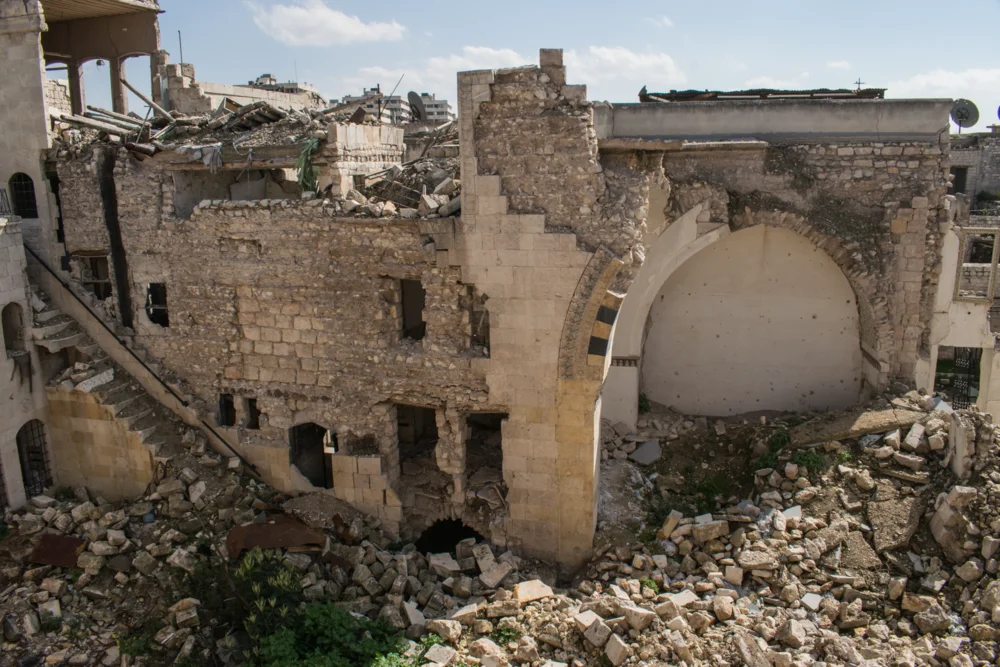
Contradictory attitudes to the cultural heritage: claimed by some, ignored or rejected by others, plundered by all and destroyed by war
Before the war, traces of the inherited urban way of life, scattered throughout the city and intermingled with new architectural styles and new practises, had already become difficult to read; the war accentuated this difficulty. The loss of cultural heritage is manifested both through the destruction of traditional living environments and through the disappearance of monuments. Houses have been looted, burnt, blown up or bombed – as were the suqs and thousands of other historic buildings – leading to the disappearance of a very old culture which had already been transformed by tourism or is considered backward-looking.
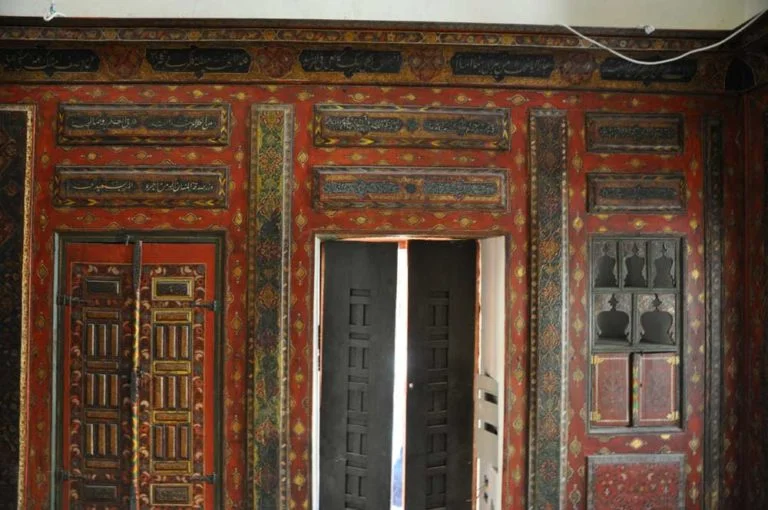
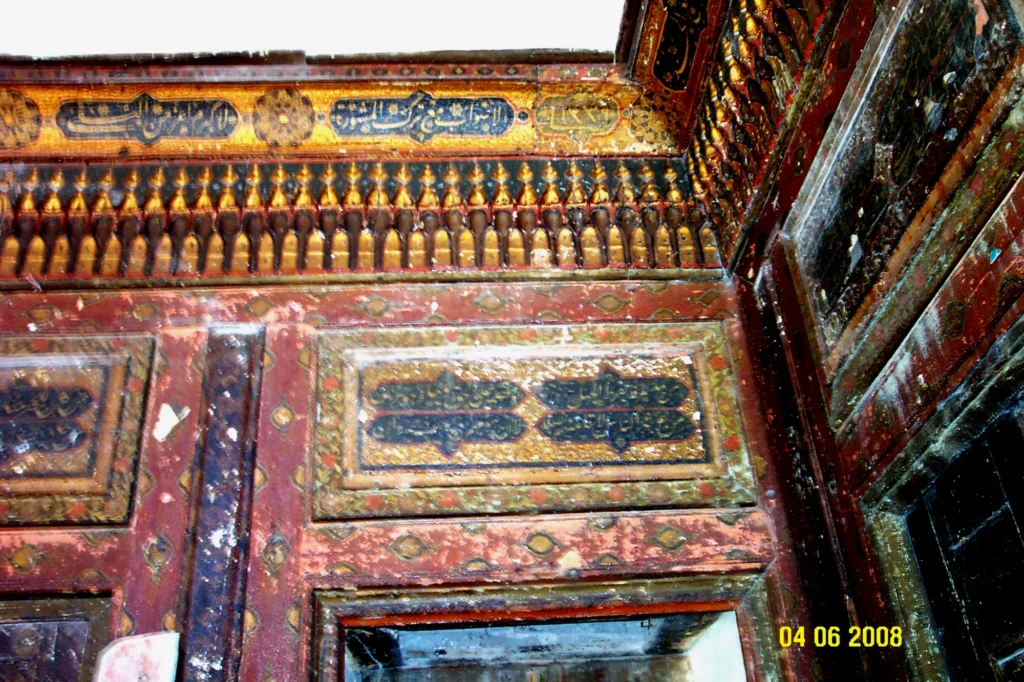
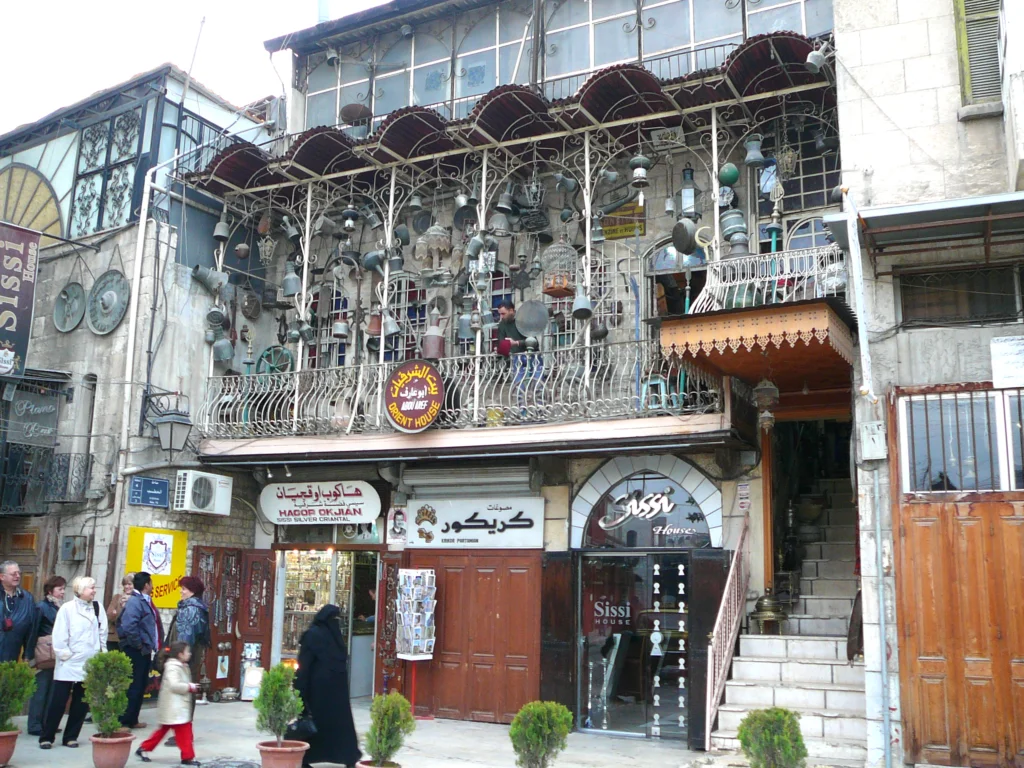
The war has prompted some people to radically change the way they look at the past. Before the conflict, decisions about the classification of monuments or urban areas took into account the development of tourism and a Western point of view. Some actors questioned this non-local viewpoint favouring instead perspectives more rooted in Arab and Muslim culture. The relationship with the city’s cultural heritage became more ambiguous, ranging from identity claims to the desire to sell it to property developers to enable investment. There are some among the fighters who take a critical look at this form of valorisation of heritage. The destruction of cultural heritage could be understood as a rejection of the West and a wish to liquidate a kind of Eurocentrism implied by the promotion and development of tourism (Fig. 6).
The Museum of Aleppine Memories project was needed to encourage Aleppo’s inhabitants to look beyond grade school clichés and mosque sermons to recognize the value of their city’s heritage. The destruction of this museum, which was in the process of being set up, undoubtedly has a strong ideological and political significance: it is a kind of rejection of history and of heritage, even if the destruction can be considered a coincidence of war (Fig. 7, 8).


The Judayda Quarter and the house that became Ghazala – representatives of the prosperity of the first Ottoman century in Aleppo

Following the Ottoman conquest in 1516, four centuries before the modernization brought by the West in the 20th century, the city underwent a progressive reorganisation in a movement that had been initiated at the end of the Mamluk period (Fig. 9). Most of the traditional manufacturing activities were relocated from the central suqs to the emerging suburbs, notably in the north, in Judayda, with its mixed Muslim-Christian environment. The authorities favoured the immigration of Christians, who were widely involved in the economic activities of the city and installed themselves in the neighbourhoods which already housed their churches (attested in the 15th century). A major development measure was the establishment of a first large Muslim waqf (endowment) in Judayda, that of governor Bahram Pasha, in 1583. It included the city’s largest hammam, a qaysariyya for craftsmen (in Aleppo this is generally an ensemble of rooms intended for a craft activity, often distributed around a courtyard and rented out; it often belongs to a waqf) and a suq. The second and even more important Waqf of Ibshir Pasha, built in 1653, constitutes the centre of Judayda and contains several suqs for trade and local services as well as qaysariyyas reserved for textile workers (Fig. 7, 8). The Ghazala House is built on the edge of the church quarter and lies in the vicinity of these waqfs with which it is more or less contemporary. However, most of the Christian merchants and bankers who lived in Judayda and the adjacent neighbourhoods usually had their offices in the central caravanserais (khans), which formed the main commercial and financial centre, a ‘City’ (Khan al-Jumruk dates from the 16th century). They worked with European merchants and consuls or for Muslim notables, major landowners and tax farmers who collected taxes from the agricultural sphere and other sectors of production. They also acted as lenders for grain producers and cattle farmers.
[1] “Ghazala” after the name of the last owners of the house (Arab. bayt), the Ghazala family. The name can be transliterated in different ways.
Featured image: The courtyard with iwan and T-shaped hall (qa’a) after the destruction, 2017 | Collection: May Ghazalé Sikias, photo: André Yacoubian (CC-BY-NC-SA)
Translation of the French text:
Jean-Claude David. La guerre d’Alep 2012-2016. Destruction de la maison Ghazalé (1/2), ArchéOrient – Le Blog, 9 mars 2018.
Published by Jean-Claude David: Jean-Claude David, a retired researcher at the Université Lumière Lyon 2 and an associate researcher at the Laboratoire Archéorient – Environnements et sociétés de l’Orient ancient, Maison de l’Orient et de la Méditerranée, Lyon (UMR 3155 CNRS), is a geographer and specialist in Near Eastern cities.
See more articles about Ghazala House and ʿajami decoration:
Beit Ghazaleh: The House of My Great Grandparents (syrian-heritage.org)
‘Ajami or Damascene Painting: Traces of a Traditional Handcraft
Conserving ‘Ajami Interiors – Challenges and Fascinating Discoveries
Grandmasters of the ‘Ajami Craft
Becoming a Craftsman: Interview with Mohammad Haj Qab
Between Traditions and Innovation: Interview with Aliya Alnuaimi
Secrets of the Old Master Artisans
The Soul of ‘Ajami: Interview with Ziad Baydoun
The Aleppo Room …from a Personal Viewpoint
ʿAjami in Aleppo: A Tale of Traveling Motifs (syrian-heritage.org)
